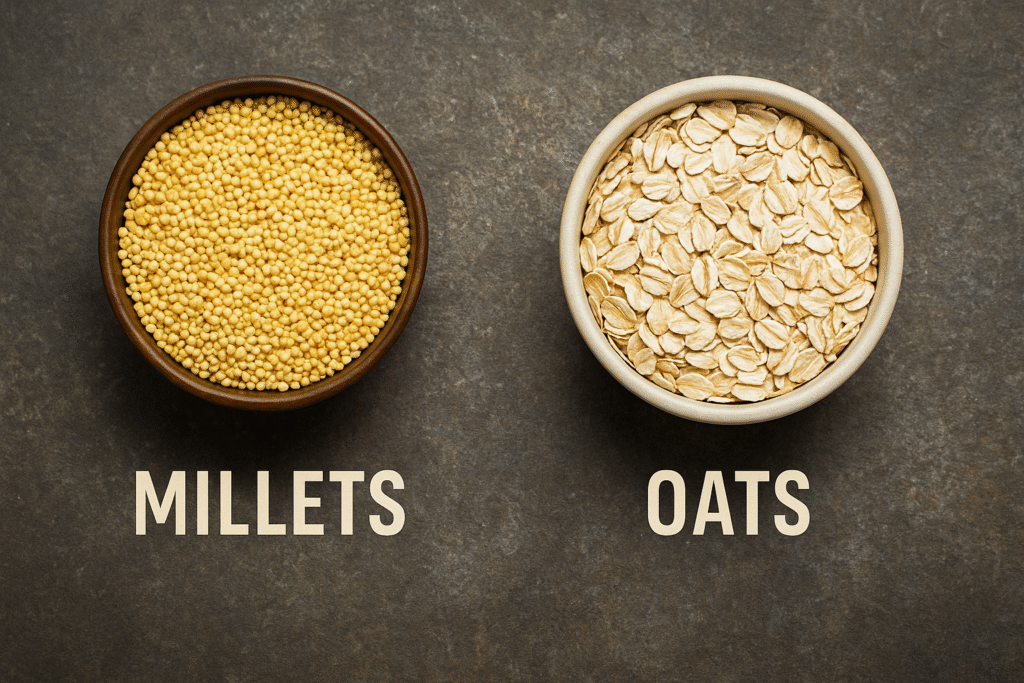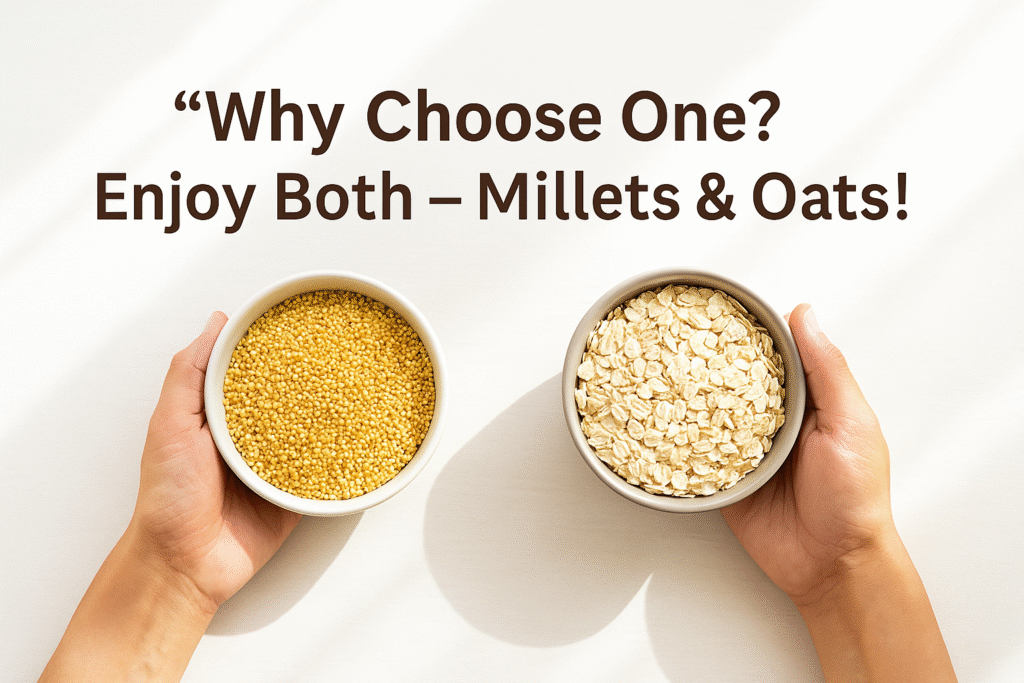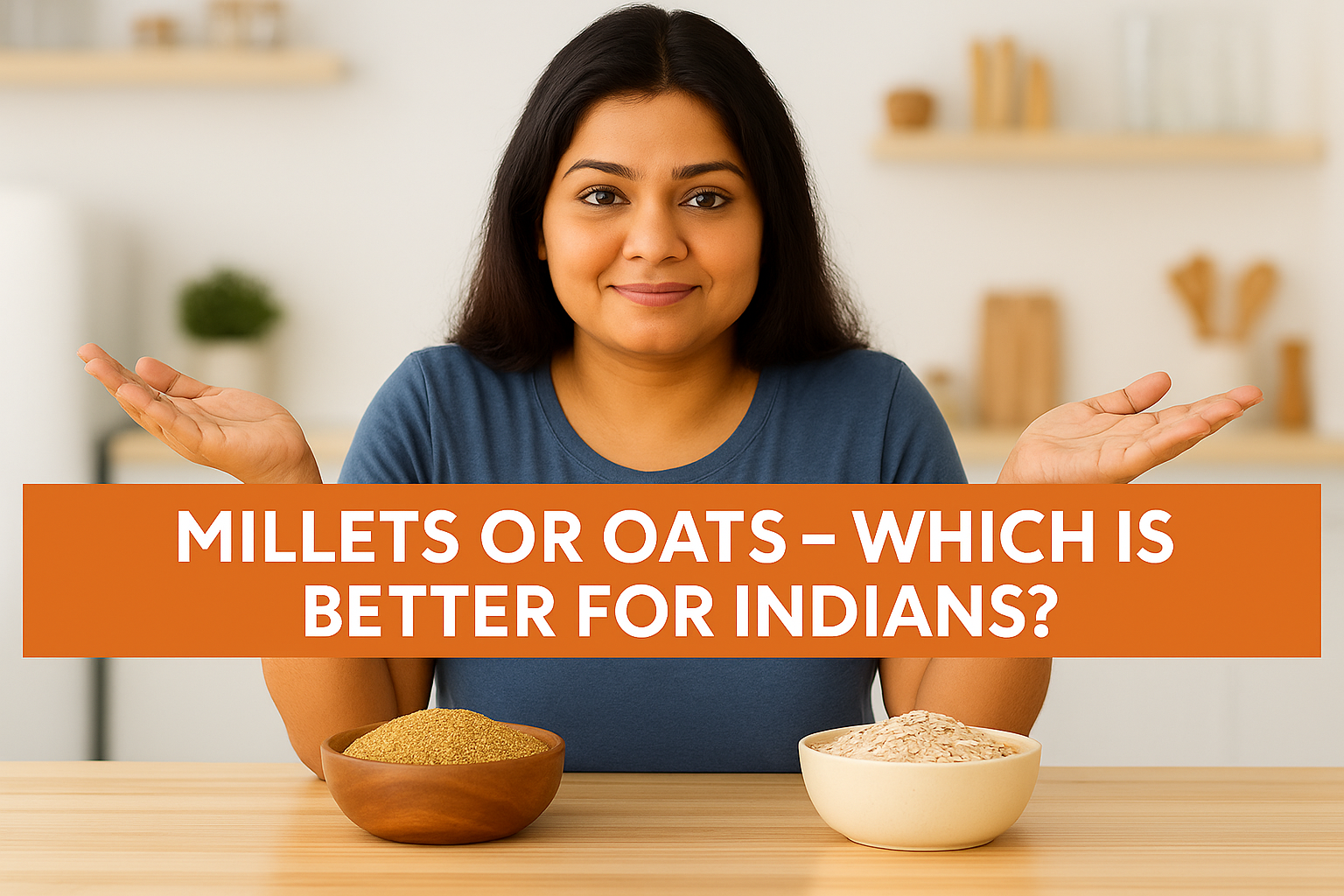Walk into any grocery store now and you’ll see shelves packed with millets and oats sitting side by side, almost daring you to choose one. Everyone’s talking about eating smart, staying fit, and finding the grain that works best for Indian meals. Folks scroll through Instagram reels where someone’s praising oats for heart health while another person swears by ancient Indian millets for weight loss. And the confusion begins.
Both grains have become symbols of a health-first lifestyle in India. Millets are part of our old food wisdom, while oats came from the West but found their way into every breakfast table. Each has its charm, its set of nutrients, and its price tag. The real question isn’t just which one is “better” but which one suits our Indian body type, climate, and taste buds.
Let’s talk about what makes millets vs oats such a hot topic for Indian households and which one you should actually scoop into your next meal.
Understanding Millets and Oats – What They Mean in the Indian Context
Millets aren’t new to India; they’ve been around for thousands of years. Our grandparents grew up eating ragi, bajra, jowar, foxtail millet, and barnyard millet. These grains were easy to grow, handled tough weather, and kept people full for long hours. The problem was — once polished rice and wheat became fancy, millets took a backseat.
Millets are rich in fibre, minerals like iron and calcium, and they’ve got a low glycaemic index, making them solid for diabetics and weight-watchers. They’re also gluten-free and easy on the stomach. These small grains pack a punch in taste and nutrition, and they actually match the Indian climate better than most modern crops.
What Are Oats and How They Became a Breakfast Staple in India
Oats, on the other hand, came into India much later. You’ll see them mostly as rolled oats, instant oats, or steel-cut oats. Most folks love them because they cook fast and make a nice creamy porridge. Oats have beta-glucan fibre, a heart-friendly compound that can reduce cholesterol and keep you feeling full.
Indian households have started using oats beyond porridge too — like in oats dosa, oats upma, or even homemade oats laddoos. They’re affordable, quick, and taste pretty mild, so people mix them easily with masala or milk.
So yeah, both have strong fan clubs — one backed by tradition, the other by modern health trends.

Nutritional Comparison – Millets vs Oats for Everyday Indian Eating
| Nutrient (per 100g) | Millets (avg) | Oats |
|---|---|---|
| Protein | 11g | 16.9g |
| Fibre | 8g | 10g |
| Carbohydrates | 60–65g | 66g |
| Fat | 3–4g | 7g |
| Calcium | 100mg (varies) | 54mg |
| Iron | 3–9mg | 4.7mg |
| Glycaemic Index | 40–50 (low) | 55 (moderate) |
Millets are slightly lower in calories and carbs. Oats win in protein and soluble fibre. Both are solid options for weight loss, energy, and gut health.
In simple words, millets are earthy and mineral-rich, while oats are creamy and heart-friendly.
Health Benefits of Millets for Indians Trying to Eat Clean
If your main goal is to lose weight or keep diabetes in check, millets are your best buddy. Their low GI (glycaemic index) means your blood sugar won’t spike quickly after meals. That means fewer sugar crashes and better energy through the day. Many Indians switch to ragi rotis or bajra khichdi for this exact reason.
They also digest slowly, so you stay full longer. That’s why people trying to cut calories love millets — they reduce hunger pangs and stop you from reaching for snacks too soon.
Millets Provide Natural Minerals for Bone, Heart, and Gut Health
Some millets like ragi are packed with calcium, great for bones and kids in growth stage. Foxtail millet helps with digestion, and barnyard millet is known to detox the system gently. It’s almost like old Indian food wisdom coming back with a modern badge of “superfood”.
Millets Support Sustainable Indian Farming and Climate
Millets are not just healthy for people but also for the planet. They need very little water, grow fast, and handle dry Indian climates. That’s why the Indian government is also pushing for “Shree Anna – the millet revolution”. When you eat millets, you’re also supporting local farmers and climate-smart food systems.
Health Benefits of Oats That Fit the Modern Indian Lifestyle
Oats are known for their beta-glucan fibre, which can reduce LDL (bad cholesterol) and improve heart health. For people who eat heavy, oily food or live a fast-paced city life, oats balance things out. A warm oats bowl in the morning with fruits and milk can genuinely set your day right.
Oats Offer Quick Meals for Busy Indian Families
Life’s fast, yaar. Sometimes you just don’t have the time to soak and cook millets for hours. That’s where oats step in. They cook in just 5 minutes, and you can twist them any way — masala oats, oats idli, or even savoury oats khichdi. The convenience factor is unbeatable.
Some Cautions About Oats You Should Know
Most oats available are imported and may go through processing. Also, while oats are naturally gluten-free, they can get contaminated during packaging. If you’re sensitive to gluten, pick certified gluten-free oats.
Which Grain Should Indians Actually Choose – Millets or Oats?
If you’re trying to lose weight or manage diabetes, millets win by a small margin due to their low GI and high minerals. If your main goal is heart health and quick energy, oats are a great pick.
- For weight loss: Go for ragi, foxtail, or kodo millets
- For heart health: Stick with oats (rolled or steel-cut)
- For everyday meals: Mix both in your weekly plan
Meal Timing and Preparation Ideas for Indian Homes
Use millets in your lunch or dinner — millet rotis, khichdi, or dosa keep you full longer.
Keep oats for breakfast or evening snacks — quick, easy, and light on the tummy.
Some people mix both grains too — millet-oat dosa or oats-ragi porridge is catching up on social media. Play around and see what your taste buds say.
Balanced Indian Diet – Why Not Both?
Honestly, you don’t need to pick sides. Both are nutrient-dense and complement each other. Millets bring local minerals and sustainability. Oats bring global fibre and comfort. The magic’s in balance.
Recipe Ideas and Indian-Style Meal Suggestions
- Ragi Porridge with Jaggery – sweet, iron-rich and perfect for breakfast
- Bajra Khichdi – earthy, comforting, ideal for lunch
- Foxtail Millet Upma – spicy, quick, and great for office tiffin
- Masala Oats – hot, flavourful, ready in 5 minutes
- Oats Dosa – crispy and healthy for a Sunday brunch
These are not fancy dishes; they’re simple, homely, and can easily fit into a daily Indian diet. The best part is they taste familiar and keep the body happy.
Buying, Storage, and Cost Tips for Indian Households
You’ll find good quality millets in local grocery stores, organic shops, and online sites like 24Mantra, Organic India, and even Amazon. Oats are easy to find — Quaker, Saffola, Bagrry’s, and True Elements are common brands.
How to Store and Keep Them Fresh
Keep both in airtight containers away from moisture. Millets last longer if you roast them slightly before storing. Oats need a cool dry place or they might catch a smell during monsoon.
Cost Comparison
In India, millets range from ₹60–₹120 per kg depending on type. Oats are ₹100–₹180 per kg. Millets grown locally are cheaper, especially in rural markets, while oats sometimes cost more since they’re imported.

Conclusion – The Balanced Way Forward for Indian Families
The truth is, this isn’t a competition. Both millets and oats have something great to offer. Millets are traditional, sustainable, and full of local nutrients that suit our Indian weather and metabolism. Oats are modern, quick, and rich in soluble fibre that supports heart and gut health.
If you’re an Indian looking for the right grain, the best answer might be don’t choose just one. Mix them. Rotate them. Eat millet khichdi for lunch and oats porridge for breakfast. Add your touch of spices, veggies, or curd, and let both grains work for your body.
Healthy eating in India doesn’t have to be boring or strict. It’s about smart swaps, local choices, and listening to what your body feels good with. So next time someone asks, “millets or oats – which is better?”, you can just smile and say, “Why not both?”

